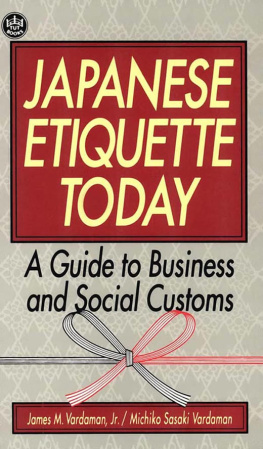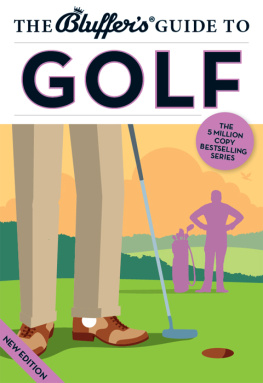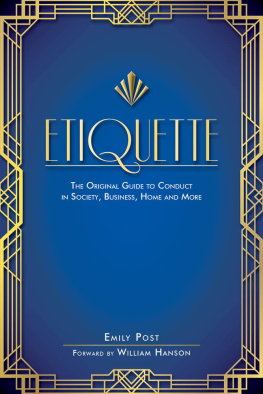Hanson - The Bluffers Guide to Etiquette
Here you can read online Hanson - The Bluffers Guide to Etiquette full text of the book (entire story) in english for free. Download pdf and epub, get meaning, cover and reviews about this ebook. City: New York, year: 2014, publisher: Bluffers Guides, genre: Home and family. Description of the work, (preface) as well as reviews are available. Best literature library LitArk.com created for fans of good reading and offers a wide selection of genres:
Romance novel
Science fiction
Adventure
Detective
Science
History
Home and family
Prose
Art
Politics
Computer
Non-fiction
Religion
Business
Children
Humor
Choose a favorite category and find really read worthwhile books. Enjoy immersion in the world of imagination, feel the emotions of the characters or learn something new for yourself, make an fascinating discovery.
- Book:The Bluffers Guide to Etiquette
- Author:
- Publisher:Bluffers Guides
- Genre:
- Year:2014
- City:New York
- Rating:5 / 5
- Favourites:Add to favourites
- Your mark:
- 100
- 1
- 2
- 3
- 4
- 5
The Bluffers Guide to Etiquette: summary, description and annotation
We offer to read an annotation, description, summary or preface (depends on what the author of the book "The Bluffers Guide to Etiquette" wrote himself). If you haven't found the necessary information about the book — write in the comments, we will try to find it.
The Bluffers Guide to Etiquette — read online for free the complete book (whole text) full work
Below is the text of the book, divided by pages. System saving the place of the last page read, allows you to conveniently read the book "The Bluffers Guide to Etiquette" online for free, without having to search again every time where you left off. Put a bookmark, and you can go to the page where you finished reading at any time.
Font size:
Interval:
Bookmark:


Hammersley House
5-8 Warwick Street
London W1B 5LX
United Kingdom
Email:
Website: bluffers.com
Twitter:
First published 2014
Copyright Bluffers 2014
Publisher: Thomas Drewry
Publishing Director: Brooke McDonald
Series Editor: David Allsop
Design and Illustration: Jim Shannon
All rights reserved. No part of this publication may be reproduced, stored in a retrieval system or transmitted in any form or by any means, electronic, mechanical, photocopying, recording or otherwise, without the prior permission of Bluffers.
A CIP Catalogue record for this book is available from the British Library.
Bluffers Guide, Bluffers and Bluff Your Way are registered trademarks.
| ISBN: | 978-1-909937-00-0 (print) 978-1-909937-01-7 (ePub) 978-1-909937-02-4 (Kindle) |
CONTENTS

People who try to pretend theyre superior make it so much harder for those of us who really are.
Hyacinth Bucket
Keeping Up Appearances

TO THE MANNERS BORN
E tiquette is a product of France, which comes as a great annoyance to the British who would like to be able to claim its invention as their own. Louis XIV (1638-1715), the foppish Sun King, decided to come up with little tickets to place around his palace at Versailles for his courtiers to observe. Keep off the grass (or, more correctly, dfense de marcher sur le gazon ) is widely thought to have been the very first of these tickets, as Versailles did and still does have lovely lawns that would be spoiled by clodhopping paysans tramping all over them.
The irony is that the country which largely eliminated its upper classes in the revolution of 1789 has to a great extent written the lexicon of etiquette. You will therefore need to possess an easy familiarity with such words and expressions as lse-majest, noblesse oblige, politesse, place table, de rigueur All will become clear in due course.
You must also be aware that manners and etiquette are more or less the same thing; do not even begin to suggest otherwise. They are most certainly bedfellows; manners need etiquette to survive and vice versa. Manners are the guiding principles of respect and social interaction, and etiquette is the unwritten code of exact rules. Such as with football the aim is to score a goal, and things like the offside rule help you to fairly and correctly score that goal . Apparently.
Some may think that in the ber-progressive second decade of the twenty-first century (there is no hard and fast rule about how to describe this period, but please dont say teenies), etiquette would have died a death. Au contraire! In Britain we are now even more obsessed by social codes and politesse than ever before. You may be more Crystal Palace than Buckingham Palace, but with the right knowledge you will go far. Families like the Middletons are prime examples.
But, like them and the rest of us, there are occasions when you will have to bluff. And here you enter perilous territory, which is where this short guide can offer invaluable help. It sets out to conduct you through the main danger zones encountered in discussions about etiquette in British society, and to equip you with a vocabulary and evasive technique that will minimise the risk of being rumbled as a bluffer. It will give you a few easy-to-learn hints and methods that might even allow you to be accepted as an etiquette expert of rare ability and experience. But it will do more. It will give you the tools to impress legions of marvelling listeners with your knowledge and insight without anyone discovering that, until you read it, you probably didnt know the difference between comme il faut and a faux pas .
The author cannot take this analogy further as and this may come as a shock he does not care for the sport.
HOW DO YOU DONT
GREETINGS AND SMALL TALK
Men in white coats have concluded that we judge someone within the first three to six seconds of meeting them. Those who go around making bold proclamations like I dont care what people think of me are lying (and not doing a good job of hiding it). Of course they care. We all do. As the old clich tells us, we only have one chance to make a first impression. Everything, from what we wear, to how we look, to what we say, counts.
But let us begin by focusing on what should (and should not) emanate from the mouth if the bluffer wants to be accepted as a member of polite society.
Do say How do you do? Dont say Pleased to meet you.How do you do? is a rhetorical question and those who answer it will have fallen at the first hurdle. Instead, repeat it back at your interlocutor, together with your name. Thus, the ideal greeting will go like this:
Mr Smith Good morning, how do you do? John Smith. Mr Jones George Jones, how do you do?Pleased to meet you should be avoided for two reasons. The first is that if you have never met them before, you do not know if you are pleased to meet them or not, and we can leave this sort of treacly insincerity to the Americans, who are all having nice days. Second, among certain social strata, pleased (or nice) to meet you is treated as rather suspect. When the Middleton family first entered into Prince Williams life, his peers apparently referred to them as the Nice-to-meet-you Middletons.
Im so glad to meet you at last, or words to that effect, is acceptable when meeting someone with whom you may have exchanged emails, telephone conversations, tweets and the like. In that instance, How do you do? may seem a bit too aloof.
THE HANDSHAKE
Although you must pick your moment, your audience will be greatly impressed if you can casually drop into conversation the origins and reasoning behind the handshake. We all shake hands frequently, but surprisingly few people realise why.
Historically, gentlemen would frequently carry swords as you could never be quite sure who your friends were. When about to engage in combat they would unsheathe their weapons using their right hand, as the sword was carried in a scabbard on their left hip. When meeting someone who was a friend they would show that they meant them no harm by presenting their right hand, away from the left hip, palm open to confirm they were not holding a weapon. The fact that some frightful cads then produced a dagger in their left hand and stabbed their unsuspecting friend is a minor detail you can leave out.
So thats the history sorted, but you need to back up your knowledge with a good shake yourself. Its the only skin-onskin contact you will (probably) have with that person, and many will judge others on the quality of their wrist action:
Use your right hand, even if you are left-handed. You only shake with the left hand in the Scouts or if you have no right hand (in these circumstances the bluffer must improvise). Make eye contact. No need to stare, but avoiding eye contact implies nervousness or dishonesty; even if you do feel nervous because youre meeting a social superior, dont show it. This is early bluffing territory in the world of etiquette. Keep them guessing. Shake once or twice. In China, the handshake will go on for much longer in fact, so long that wrists have been known to get sprained. But in Britain we just get it over and done with as quickly as possible. Strength of grip is important. Knuckle-crunching impresses nobody and smacks of trying too hard. Soft, moist and limp conveys timidity. Aim for somewhere in between. Smile! Nothing is more certain to make a good impression than a good smile. Again, dont go overboard by doing a hideous impersonation of Tony Blair; just smile quite naturally.Next pageFont size:
Interval:
Bookmark:
Similar books «The Bluffers Guide to Etiquette»
Look at similar books to The Bluffers Guide to Etiquette. We have selected literature similar in name and meaning in the hope of providing readers with more options to find new, interesting, not yet read works.
Discussion, reviews of the book The Bluffers Guide to Etiquette and just readers' own opinions. Leave your comments, write what you think about the work, its meaning or the main characters. Specify what exactly you liked and what you didn't like, and why you think so.
















